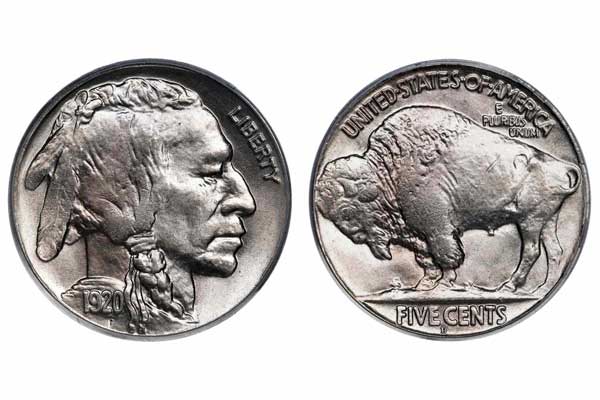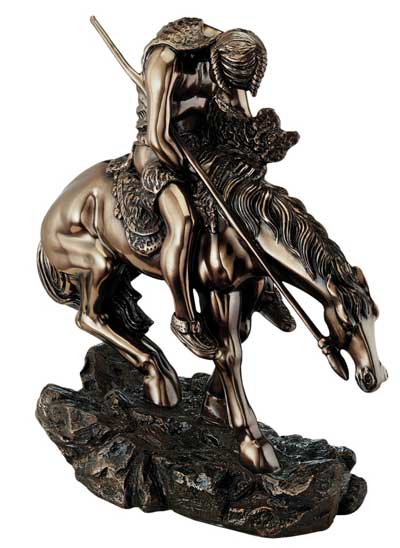The Indian Head Nickel
The Buffalo Nickel (officially the Indian Head Nickel) is a U.S. five-cent coin featuring a portrait of a Native American Indian on one side and an image of a buffalo (bison) on the other. It was designed by sculptor James Earle Fraser in 1912 as part of the U.S. Mint's campaign to beautify American coinage. It was produced at the Philadelphia, Denver, and San Francisco Mints from 1913 to 1938.

The first coins were distributed on February 22, 1913 at the groundbreaking ceremony for the National American Indian Memorial at Fort Wadsworth, Staten Island, New York. Forty nickels were sent by the Mint for the ceremony in which most of the coins were distributed amongst the Native American chiefs who participated in the ceremony. After the ground breaking ceremony, the memorial was never built and was dubbed a "philanthropic humbug" by the media.
The Indian head nickel turned out to be difficult to coin. The coins tended to strike indistinctly and were subject to wear with the dates easily worn away in circulation. The Treasury was eager to discontinue the coin. In 1938, after the expiration of the minimum 25-year period during which the design could not be replaced, it was replaced by the Jefferson nickel. Fraser's buffalo design continues to be admired and has been used on commemorative coins such as the silver and gold American Buffalo coin series.
The Buffalo Nickel can be worth anywhere from $0.51 for a 1937 coin in "good" condition to $1,524 for a 1921 S coin in "mint" condition.
The Buffalo Nickel is said to have been designed to commemorate the American Indian and was hence introduced at the proposed National American Indian Memorial. The designer, James Earle Fraser, in 1947, 35 years after the design, discussed his design and stated that he wanted to do something totally American and create a coin that could not be mistaken for any other country's coin. He felt that the buffalo, as part of our western background, was 100% American, and that the North American Indian fitted into the picture perfectly.
Prior to 1947, there is no record of the meaning behind the design or what the Indian Nickel was intended to symbolize.
However there are circumstances that suggest that the reasons depicted in 1947 may not have necessarily been the reasons for the design in 1912.
Although James Earle Fraser was born in Minnesota and lived his later years in New York, James was raised near Mitchell, South Dakota. Frasier was most certainly influenced by the long history of Indian conflicts in the region. Frasier's father, a railroad engineer, spent the summer of Fraser's birth gathering up the remains of George Armstrong Custer's Seventh Cavalry members who perished at the Battle of the Little Bighorn. The Battle of Wounded Knee and the Drexel Mission Fight both took place in South Dakota the year Fraser left to attend classes at The School of The Art Institute of Chicago. These early experiences, and those of his father, may have influenced the meaning behind the buffalo nickel.

It is said that General Philip Sheridan once suggested to the Texas legislature that buffalo hunters should be given a medal engraved with a discouraged-looking Indian on one side and a buffalo on the other. Although some historians dispute that Sheridan ever made these remarks and suggest it is an apocryphal, these charges were well known and circulated in 1907, only a few years before Fraser's design depicting an Indian on one side and a buffalo on the other, very similar to Sheridan's alleged metal. Fraser most certainly would have known of Sheridan's proposed buffalo metal.
Shortly after the Buffalo Nickel, in 1915, Fraser sculptured the famous "The End of the Trail" sculpture, one of the most iconic images of American Indians. It depicts a Native American man slumped over an exhausted horse standing gingerly at the end of the trail, overlooking, Fraser said, the Pacific Ocean. It symbolizes the American Indians being driven out of all of their traditional homelands farther and farther west until there was nowhere left for them to go. The Indian is holding a lance which is pointed toward the ground in defeat. Fraser fashioned the lance so that from a distance it appears to have pierced through the Indian. Frasier first modeled this sculpture in 1894 based on his experiences as a boy in the Dakota Territory.
Whether the "The End of the Trail" represents sympathy with the plight of Native Americans with "nobility in defeat" and "dignity in loss" or celebrates "the end of Indian resistance" and the "vanishing Indian" is a matter of interpretation of Fraser's true intent. As Fraser suggested about the sculpture, once Native American resistance to the white conquest of the continent was over, "Indians" would simply disappear over the horizon.
The End of the Trail sculpture brings us all back to the Buffalo Nickel and the 1913 groundbreaking ceremony for the National American Indian Memorial at Fort Wadsworth. Although many consider the Wounded Knee Massacre in 1890 to be the end of the Indian Wars, it was the end of the Renegade Period and the Apache Wars in 1924 that brought the American Indian Wars to a close. Considering the treatment and condemnation of the Native American Indians by the U.S. Government, why would a coin and a memorial (which was never built) be created to honor the Native American Indian while the American Indian Wars were still being fought?
We may never know the true meaning and the original intended symbolism of the Indian Head (Buffalo) Nickel, but it is interesting to look at history from a different perspective with diverse historical facts.
Ozark Valley Bison Ranch LLC
Fox, AR
